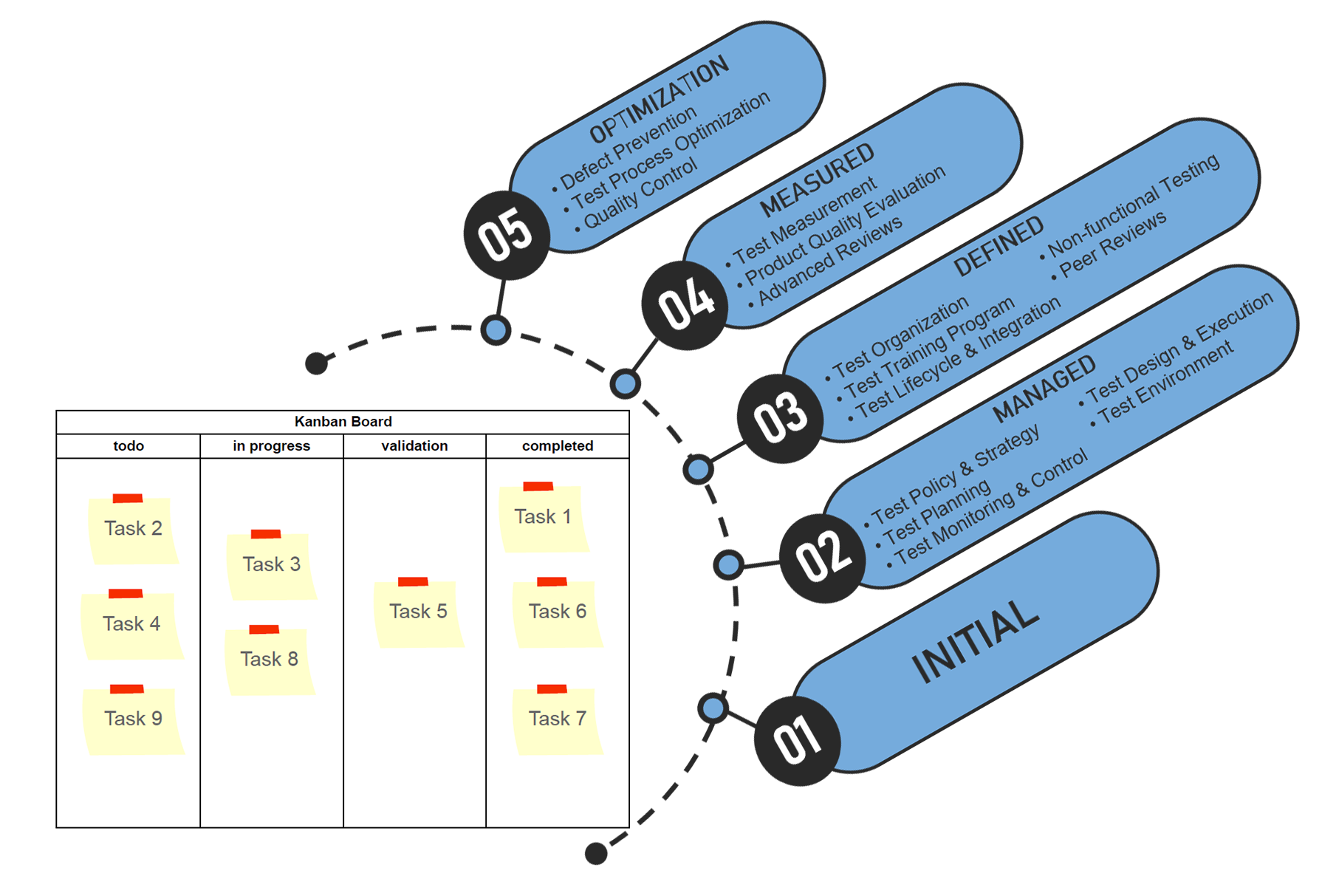Kanban and the Test Maturity Model integration (TMMi)
December 14 2023
The integration of Kanban and the Test Maturity Model Integration (TMMi) represents a strategic confluence of two powerful frameworks designed to enhance software development and testing processes. While Kanban is a visual system for managing work as it moves through a process, TMMi offers a structured approach for improving testing processes. Understanding how these frameworks can be harmoniously integrated can lead to substantial improvements in project management and quality assurance.

Kanban: Principles and Practices Kanban, with its origins in Japanese manufacturing and particularly at Toyota, is a methodology focused on enhancing efficiency through visual management. In software development and IT operations, Kanban helps teams visualize their work, limit work-in-progress, manage workflow, and engage in continuous improvement. The Kanban board is a critical tool in this system, providing a visual representation of the workflow and helping to highlight bottlenecks and inefficiencies.
TMMi: Structure and Levels The Test Maturity Model Integration (TMMi) is designed to assess and enhance the maturity of test processes. It offers a roadmap for progressing from ad-hoc testing practices to a disciplined, structured, and optimized approach. TMMi's five maturity levels—Initial, Managed, Defined, Measured, and Optimization—provide a framework for continuous improvement, with each level offering specific goals and processes aimed at enhancing testing efficiency and effectiveness.
Challenges in Integration Integrating Kanban and TMMi presents several challenges:
- Aligning the flexible, flow-based approach of Kanban with the structured, step-wise improvement strategy of TMMi.
- Ensuring that the integration does not disrupt existing workflows or lead to resistance among team members.
- Adapting the TMMi model to fit into the visual and dynamic nature of Kanban without losing the rigor of its structured approach.
Strategies for Effective Integration To effectively integrate Kanban with TMMi, consider the following strategies:
- Visualizing Testing Workflows: Extend the Kanban board to include testing phases. This visualization helps integrate testing seamlessly with development activities, promoting transparency and real-time tracking of progress.
- Limiting WIP for Testing: Establish Work in Progress (WIP) limits for testing tasks to prevent bottlenecks and ensure that testing keeps pace with development.
- Continuous Improvement: Use the iterative nature of Kanban to gradually integrate TMMi practices. Regular retrospectives can help in adapting and refining TMMi practices within the Kanban framework.
- Measurement and Feedback: Utilize Kanban metrics like lead time and cycle time to evaluate the impact of TMMi practices. This data-driven approach helps in making informed decisions to further refine testing processes.
Benefits of Integration By integrating Kanban and TMMi, organizations can leverage the strengths of both systems to create a robust framework for managing and improving software development and testing processes. Some of the benefits include:
- Enhanced visibility of testing processes, leading to better communication and coordination among team members.
- Improved prioritization and resource allocation, ensuring that critical testing tasks are addressed promptly and efficiently.
- Higher quality of software products due to more structured and disciplined testing practices integrated within the Kanban flow.
Conclusion Integrating Kanban and TMMi offers a comprehensive approach to managing and improving software testing processes within the broader context of software development. By aligning the dynamic, flexible nature of Kanban with the structured, maturity-focused approach of TMMi, teams can enhance both their efficiency and the quality of their software products.
This version provides a more complete picture of the integration, detailing the practical implementation steps, the challenges that may arise, and the tangible benefits of combining these two frameworks.
